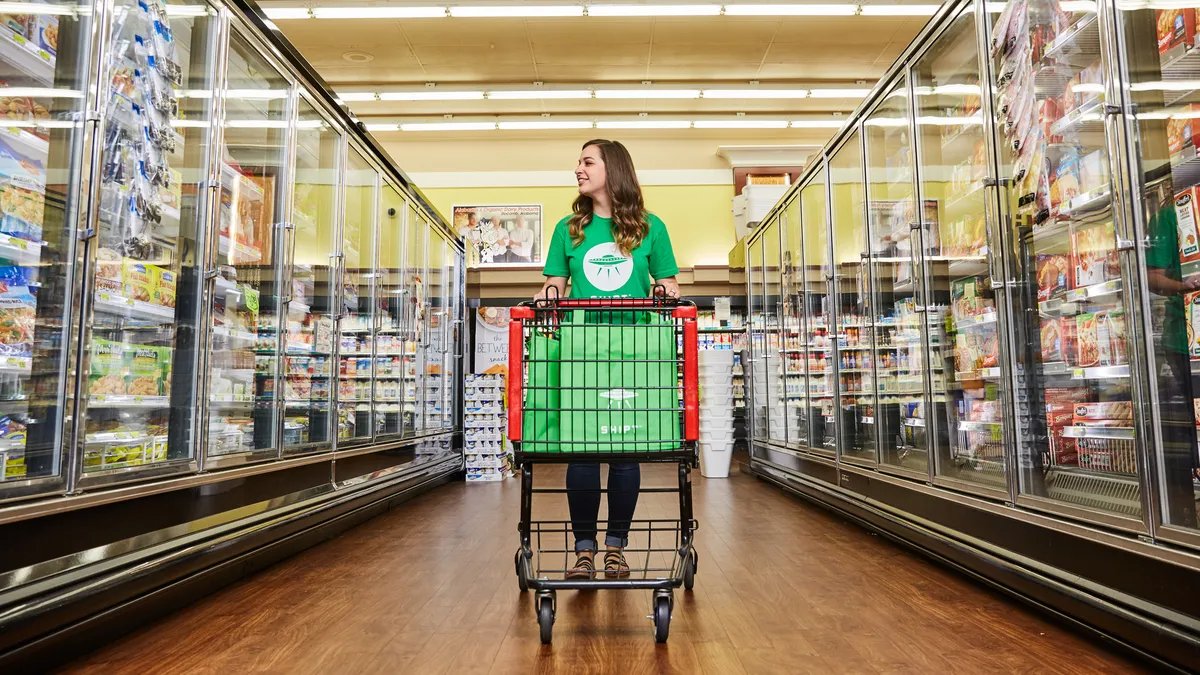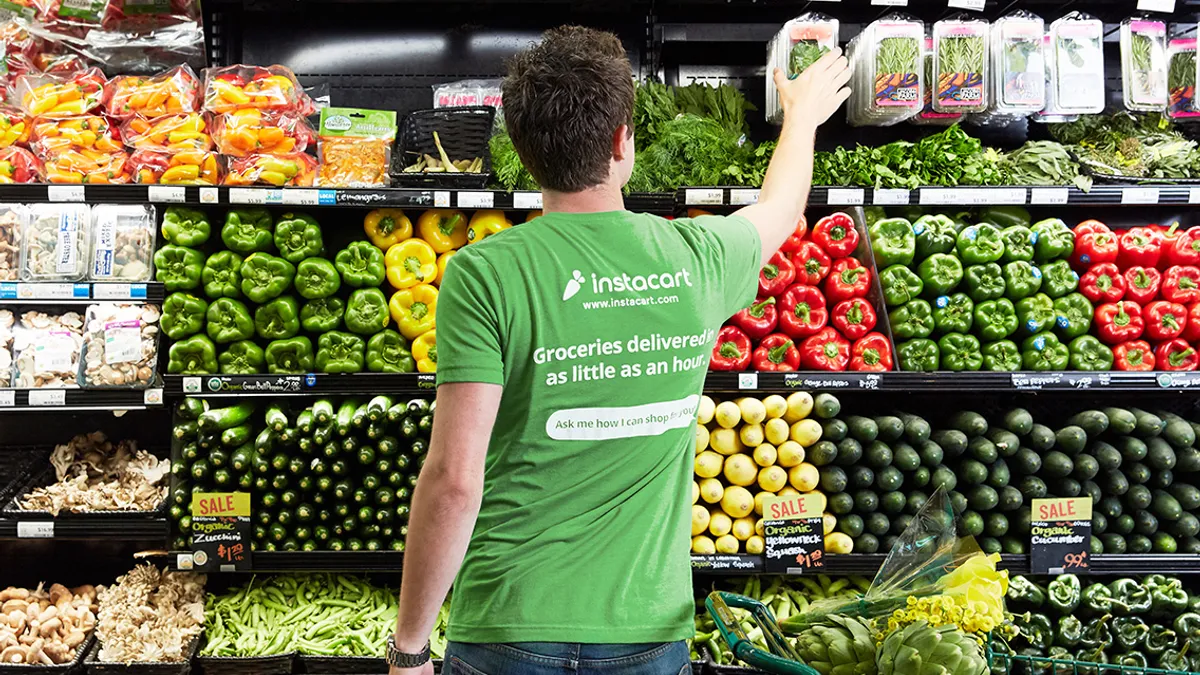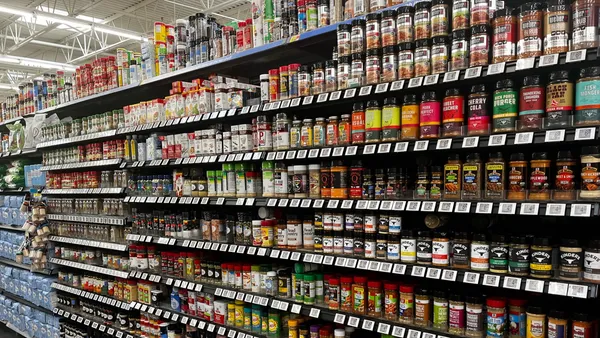This is the fourth article in a four-part series looking at labor issues affecting the grocery industry. The previous stories can be found here.
Earlier this year, e-commerce provider Shipt issued an invitation to its contract workers: Come to headquarters in Birmingham, Alabama, meet our executives and talk about your jobs.
One thousand individuals paid their way to the southern city in April and were treated to a day and a half of development, including a discussion with company leaders, a tour of headquarters, updates on the business and a presentation showing how their feedback had impacted the company. One lucky worker even won a car.
"To our knowledge, this was the first gathering of gig economy workers for the platform they work on," Kelly Caruso, a Target veteran who became CEO of Shipt earlier this year, said during a presentation at the Groceryshop conference in September.
While the company positioned the get-together as a warm team-building exercise, it also underscores the importance of keeping workers happy and loyal in an on-demand labor industry notorious for high turnover.
Gig labor has become inextricably linked to grocers’ e-commerce efforts, with hundreds of thousands of workers roaming stores selecting products, assembling orders and delivering them to consumers’ homes. And it’s set to fill even more jobs in the years ahead, both within that channel and in store-level tasks like stocking and merchandising, experts say.
But as it grows, gig labor faces pointed questions about its viability within grocery, along with broader questions regarding the sustainability of the model.
In-store gigs
The grocery industry relies on gig labor to pick, pack and deliver online orders. And that reliance is set to increase as e-commerce demand accelerates. According to eMarketer, online grocery sales are expected to total nearly $20 billion this year and rise to more than $38 billion by 2023. The Food Marketing Institute and Nielsen believe that by 2025, e-grocery will be a $100 billion business.
Grocers are also starting to bring on-demand labor into their stores to complete tasks like stocking shelves, building displays and running sampling stations. With unemployment at a historic low and grocers struggling to hang onto both full- and part-time employees, gig labor can plug the labor holes grocers need to fill.
"Employee turnover has increased year-over-year for the last three years," Bob Graybill, president and CEO of consulting firm FMS Solutions, which studies industry labor and compensation, told Grocery Dive. "Turnover is particularly high among part-time employees, upwards of 100% for regional and national chains."
Jyve, the on-demand labor company that emerged earlier this year, said it’s seeing growing demand from retailers for fill-in tasks like merchandising and shelf stocking. Anu Gupta, a former Target and Safeway executive who serves as the company’s chief operating officer, said Jyve provides grocery-specific training to its workers, or "Jyvers," who are typically devoted to a single retail brand and circulate from store to store completing tasks. The company uses artificial intelligence to forecast stores’ needs and then lines up workers according to their skills.
Stocking, merchandising and organizing displays are the top tasks retailers are currently requesting from the company, Gupta said.
The company’s growth to date is largely driven by "massive turnover" in retail, Gupta said. She continued: "While retailers and brands are aware of the need for more people during the holiday season, most aren’t prepared for the ebb and flow that occurs during the rest of the year."
Other retail sectors have turned to gig labor through providers like Snag Work. Meanwhile, the restaurant industry, where triple-digit turnover rates are common, has seen an explosion of on-demand workers filling in as waiters and short-order cooks in addition to those who deliver meals for services like DoorDash and Uber Eats. Specialized companies like 7shifts and Pared have cropped up to recruit, train and deploy networks of workers.
Micah Rowland, chief operating officer at Fountain, a hiring and employee management service that works closely with many gig companies, believes grocers are evaluating gig labor's viability beyond just online fulfillment. He predicts food retailers, which are already competing with gig companies for employees, will increasingly bring these workers into their stores.
"Grocery is a little less concentrated, so it’s going to be later down the funnel," Rowland told Grocery Dive. "But it’s looking very attractive in a very tight labor market to get costs down by putting lumpy labor expenditure in where you (normally) have a constant expenditure."
Others aren’t so sure. Todd Wulffson, managing partner at California law firm Carothers, DiSante & Freudenberger, told Grocery Dive gig workers may not follow the same standards for grooming or fit in with a team culture that grocers have established. Publix, for instance, recently lifted its ban on facial hair, but still requires employees to wear a neatly trimmed mustache or beard.
“You’re presenting a certain image to the community and the employee needs to fit in with that. And there’s liability there,” said Wulffson, who has worked closely with retailers like Kroger, Albertsons and Sprouts Farmers Market.
Even with training, he said, on-demand workers may not know the layout of the store where they’re working, which could consternate shoppers seeking help. Providing high-touch, specialized service will also be more difficult with gig workers, Wulffson noted.
"Anybody can come in and throw a box up on a shelf, but it’s going to be a unique person who can come in and talk to the average customer about the different kinds of olive oil or the 15 different types of squash and how to use them," he said.
Anne-Marie Roerink, principal and founder with 210 Analytics, which studies grocery labor, said grocers are starved for labor in departments like meat and seafood, which require specialized training.
"The more skilled positions in grocery retailing will be hard to backfill with temporary workers," she told Grocery Dive.
'Existential' questions for on-demand labor
At Jyve, Gupta said workers get access to retailer training programs through their mobile phones. They’re also expected to complete in-store tasks under the supervision of a "Jyve Guru" before they can get certified in a specific task. Workers are paid per task, not per hour, Gupta said, and the company promotes skill-building as a way to earn more money.
In addition, she said, Jyve’s Gurus provide tips on how to document their work and how to best communicate with retail managers.
Even with a steady stream of available jobs, though, gig labor firms may struggle to meet demand in the coming years. With low unemployment, gig companies — many of which took off during the Great Recession a decade ago — are competing with higher-wage jobs offering a growing array of perks. This includes grocers, many of whom have upped their starting pay and rolled out benefits like health insurance, tuition reimbursement and bonuses.
"Everyone, from grocery competitors to restaurants to call centers, is competing for labor and it is driving up turnover but also hourly wages, salaries, benefits, bonuses and the entire employee investment," said Graybill.
"It's looking very attractive in a very tight labor market to get costs down by putting lumpy labor expenditure in where you (normally) have a constant expenditure."

Micah Rowland
Chief operating officer, Fountain
For venture-backed companies offering on-demand workers in highly competitive industries, significantly boosting wages often isn’t an option. The churn rate among gig economy companies could also become unsustainable, said Rowland.
For companies like Uber and Instacart, turnover is a side effect of offering a flexible work model. But Rowland said companies can risk churning through an entire available labor force, particularly in smaller markets. He recalled a conversation he had with one gig employer on the topic.
"I asked them, 'Do you worry that at some point you will have exhausted the available labor supply and you will be dramatically short of candidates?'" Rowland said. "They had no answer for that."
According to a study published earlier this year in the Academy of Management Journal, business disruption and the cost of recruiting and training new workers can cut significantly into profitability. The researchers estimated gig companies can lose 6% in profits if their turnover rate shifts from "optimal" to "high."
"They all know that (retention) is important, but it has not yet become existentially important," Rowland said.
Companies like Instacart and DoorDash have also gotten backlash from workers who claim their compensation policies are unfair. DoorDash, under a policy that has since been revised, effectively pocketed drivers’ tip money, while Instacart faced yet another worker protest this week demanding the company increase its default tip from 5% to 10%. (Instacart said, in response, it takes all worker feedback seriously.)
Instacart and competitor Shipt both say they have a robust recruiting process and an adequate pipeline of applicants. Caruso said Shipt is "very choosy" and only selects between 8% and 10% of its applicant pool to become personal shoppers. They’ve also added perks and hosted events like Shipt's Birmingham convention to boost morale among their on-demand workers. Instacart has added an instant payment tool and another that allows its shoppers to accept orders on-demand rather than commit to working during a specific timeframe.
Last year, Instacart streamlined its training process to make it easier for shoppers to learn their jobs.
"Our shopper community is very important to us and, while we know we have more work to do, we’re proud of the progress we’ve made," Nilam Ganenthiran, Instacart’s chief business officer, told Grocery Dive in a recent interview.
Gig-ifying the workforce
There are other hurdles the gig economy must reckon with. Legislation like California’s Assembly Bill 5, which was signed into law in September and requires covered contract workers to be classified as employees, could be financially devastating for gig companies, said Wulffson. Instacart along with Uber, Lyft and other gig companies have floated a ballot measure for 2020 that would exempt them from the law and guarantee above minimum wage for on-demand workers along with access to health insurance and other benefits.
Wulffson said automation threatens to displace both on-demand and conventional grocery employees. On the e-commerce side of the business, automated warehouses both small and large promise to take fulfillment away from store aisles and the many Instacart and Shipt workers that roam them, making delivery the primary focus for on-demand labor. And even there, autonomous-vehicle delivery and drone delivery promise to eventually factor out drivers.
Some retailers aren't waiting for automation to dictate how they handle e-commerce fulfillment in their stores. Lowes Foods, Walmart and SpartanNash's banners are just a few that insist on using their own workers to pick and pack orders. While Walmart insists on doing so primarily for quality-control purposes, others do so to provide personalized service to their customers.
"Good people are one of the best competitive advantages retailers can have, even in areas like click-and-collect [and] delivery where retailers have an opportunity to build a loyal relationship between the consumer and the picker, much like the cashier or butcher for in-store shoppers," said Graybill. "Gig workers aren’t going to be able to do that."
While the exact future of gig work remains a question mark, the impact of employers like Instacart and DoorDash on grocer’s own labor management processes is clear, said Will Eadie, global vice president of sales and alliances with workforce technology company WorkJam.
Eadie, whose firm works with Australian grocer Woolworths along with Shell, Ulta Beauty and Avis, said retailers have the flexibility to engage in the sort of "open shift management" on-demand companies implement. Grocers can cross-train employees across stores and distribution centers. If a store needs a shelf stocker at a moment’s notice, Eadie said, they may be able to broadcast the opportunity and get a distribution worker who wants extra hours to fill in.
"Retailers don’t realize that within their four walls, they have a gig economy," he told Grocery Dive.





















